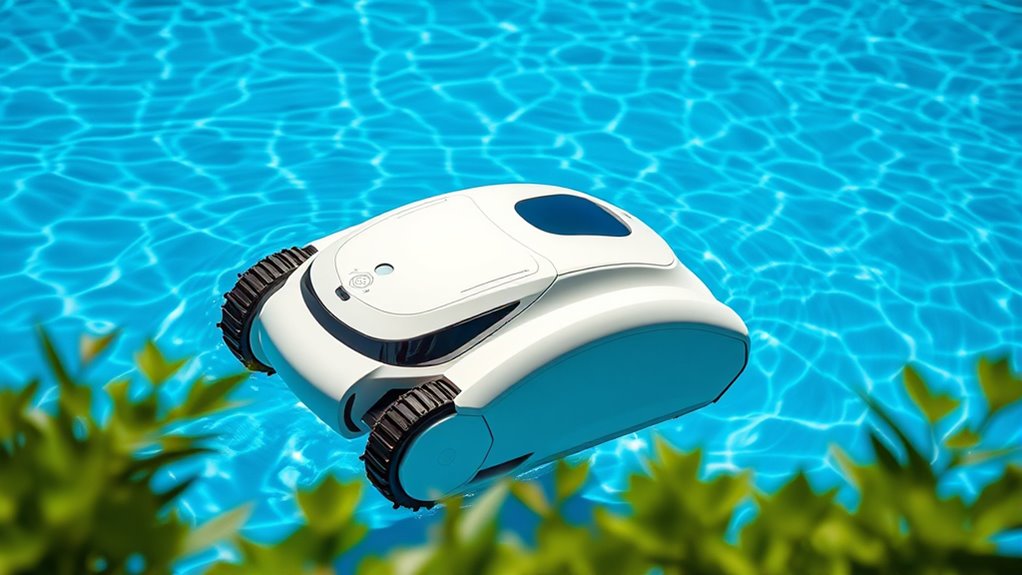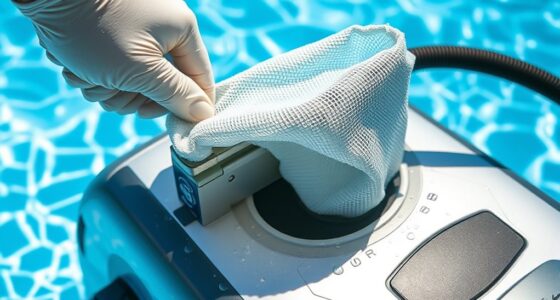Robotic pool cleaners are a smart investment if you want to save time and effort on pool maintenance. They operate independently, targeting dirt and debris with sensors and multiple brushes, while some models include scheduling and smart navigation. Although they require initial investment and occasional maintenance, their efficiency and convenience often justify the cost. Want to discover more about whether they’re worth it for your pool? Keep exploring the benefits and limitations to make an informed choice.
Key Takeaways
- Robotic pool cleaners save time and effort by automating the cleaning process, making them a convenient investment.
- Their advanced sensors and navigation ensure thorough cleaning of larger and complex pools efficiently.
- Although initial costs are higher, low maintenance and energy efficiency provide long-term savings.
- They may have limitations in cleaning corners or uneven surfaces, requiring additional manual effort.
- Overall, they offer a cost-effective solution for regular, comprehensive pool maintenance.
How Robotic Pool Cleaners Work and Their Features

Robotic pool cleaners operate independently, using advanced sensors and motors to navigate and clean your pool efficiently. Thanks to robotic technology, these devices can detect obstacles, map the pool’s surfaces, and adjust their cleaning path automatically. They typically feature multiple brushes and filters, targeting debris, dirt, and algae to keep your water clear. Their programmable timers allow you to set cleaning schedules, reducing manual effort and improving swimming pool maintenance. Many models include smart navigation systems, ensuring thorough coverage of all pool areas without missing spots. With user-friendly controls and rechargeable batteries, robotic pool cleaners simplify upkeep, saving you time and effort. Additionally, understanding the cost of electric pool cleaners can help you decide if investing in one is worthwhile for your pool maintenance routine. Proper maintenance and understanding of installation requirements can extend the lifespan of your robotic cleaner, making it a more cost-effective solution. Selecting a model with effective filtration systems ensures optimal water quality and cleaner operation, further enhancing the value of your investment. Moreover, recent advances in AI-powered navigation are making robotic cleaners more efficient and capable of adapting to complex pool geometries, providing better cleaning results. As technology advances, these devices are becoming increasingly energy-efficient, reducing operational costs and environmental impact. Overall, their innovative features make them a reliable, high-tech solution for maintaining a clean, inviting swimming pool.
Benefits of Using Robotic Pool Cleaners

Using a robotic pool cleaner offers numerous advantages that make maintaining your pool simpler and more efficient. First, it adapts to different pool sizes, guaranteeing thorough cleaning regardless of the dimensions. Second, it boosts cleaning efficiency by targeting dirt and debris more effectively than manual methods. Third, it saves you time, allowing you to enjoy your pool rather than spend hours cleaning it. Robotic cleaners are designed to navigate pool surfaces systematically, covering every inch for ideal results. With features like programmable schedules and smart navigation, you can keep your pool sparkling without constant oversight. Additionally, many models incorporate reliable technology that ensures consistent performance over time. Modern robotic cleaners often include advanced sensors that help them adapt to various pool shapes and obstacles, further improving their effectiveness. These sensors can also detect contaminants and adjust their cleaning patterns accordingly, optimizing their work. Some models even feature multi-functionality, such as scrubbing and vacuuming, to provide comprehensive cleaning solutions. Furthermore, the increasing adoption of these devices is driven by consumer demand for convenient and efficient pool maintenance options. Overall, investing in a robotic pool cleaner enhances your pool’s cleanliness, minimizes effort, and ensures consistent maintenance—making it a smart choice for pool owners.
Potential Drawbacks and Limitations
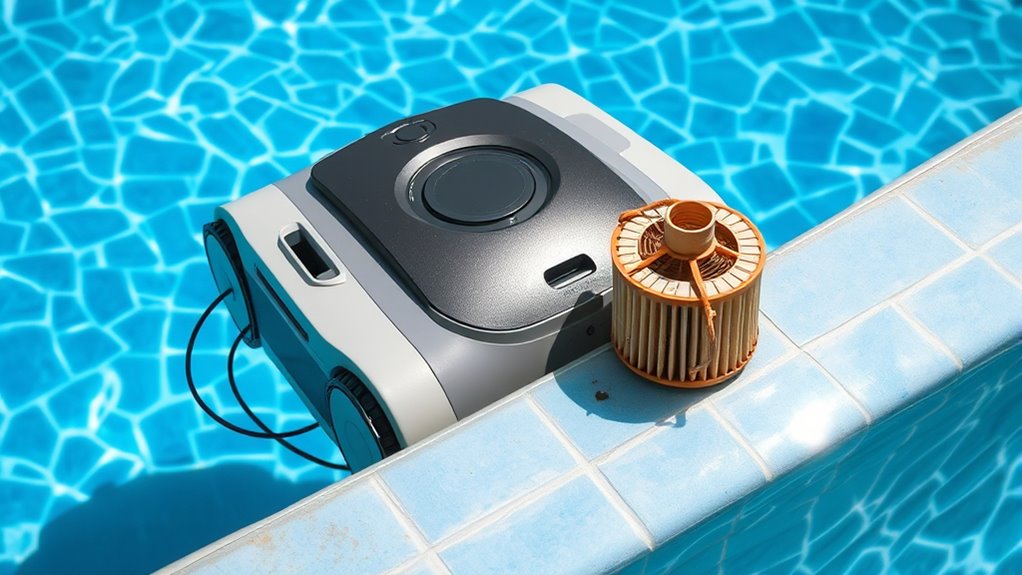
While robotic pool cleaners offer many benefits, they also have certain limitations that can impact their effectiveness. Maintenance challenges can arise, such as clogging filters or needing regular parts replacement, which may require you to troubleshoot or service the device. Technological limitations also exist; for example, some models struggle with cleaning corners or uneven surfaces, reducing their overall efficiency. Battery life can be another concern, especially if you have a large pool, as shorter runtimes mean multiple runs or frequent recharging. Additionally, connectivity issues with smart features can hinder remote control or app management. These drawbacks mean you might need to invest extra time or money to keep your robotic cleaner functioning *at its best*, which could offset some of its convenience and savings.
Cost Analysis: Are They Worth the Price?
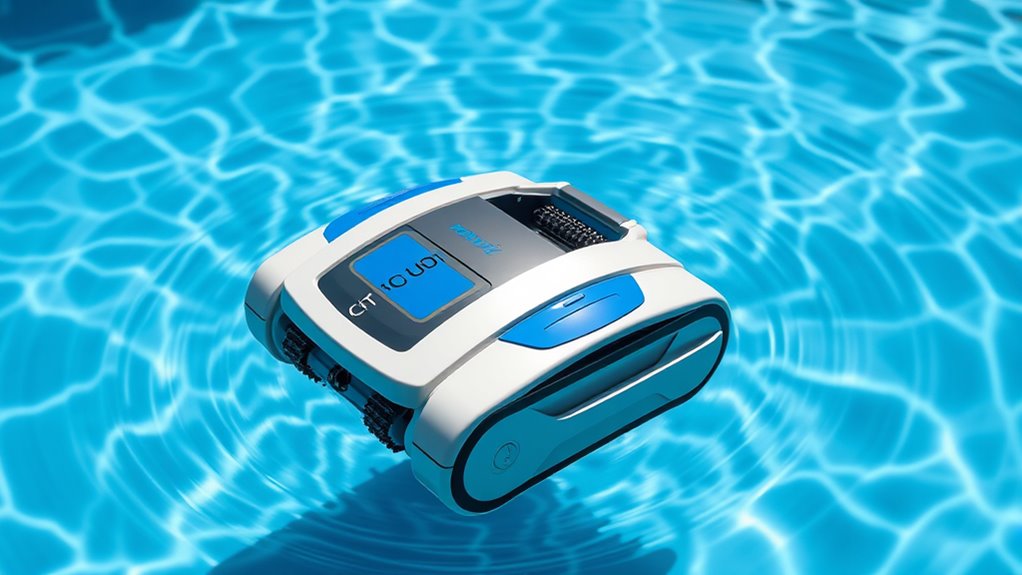
Although robotic pool cleaners often come with a higher upfront cost, many users find that their long-term savings and convenience justify the investment. Consider these factors:
- Maintenance costs are generally low, with most units needing only occasional filter replacements.
- Energy consumption is minimal compared to traditional cleaning methods, reducing your utility bills.
- Time savings means you spend less on manual cleaning or hiring help, offsetting initial expenses.
While the initial price may seem steep, these factors contribute to overall savings over time. You’ll also benefit from fewer repairs and less wear on your pool equipment, making robotic cleaners a cost-effective choice in the long run.
Making the Decision: Should You Invest in a Robotic Pool Cleaner?
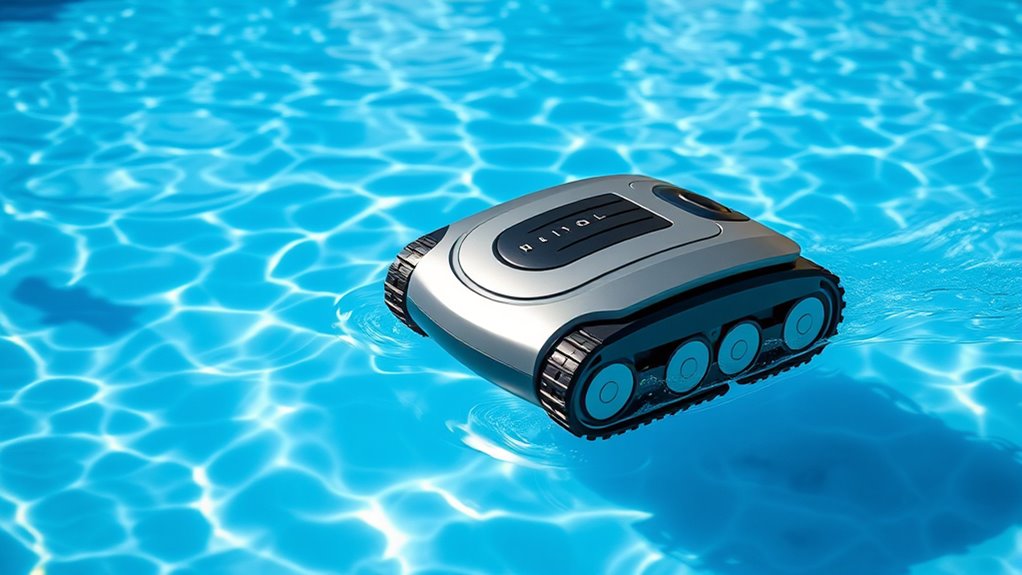
Deciding whether to invest in a robotic pool cleaner depends on your specific needs and budget. Consider how much time you want to save on maintenance tips like regular cleaning and filter checks. If you prefer a hassle-free solution, a robotic cleaner can keep your pool spotless with minimal effort. Additionally, think about its environmental impact; many models are energy-efficient, reducing electricity use compared to traditional cleaning methods. Assess your pool size and debris levels to determine if a robotic cleaner is a worthwhile investment. If you value convenience, long-term savings, and eco-friendliness, it’s likely a smart choice. Moreover, understanding the effectiveness of robotic cleaners can help set realistic expectations for their performance. Ultimately, weighing these factors helps you decide if a robotic pool cleaner fits your lifestyle and budget priorities.
Frequently Asked Questions
How Long Do Robotic Pool Cleaners Typically Last?
Robotic pool cleaners usually last around 3 to 5 years, depending on your maintenance frequency and battery life. To extend their lifespan, you should regularly clean filters, check for wear and tear, and guarantee proper storage. Battery life may diminish over time, so replacing batteries when needed can help maintain performance. Proper upkeep keeps your cleaner functioning efficiently, giving you more value and longevity from your investment.
Are Robotic Pool Cleaners Compatible With All Pool Types?
You might wonder if robotic pool cleaners work with your pool. The truth is, their pool surface compatibility varies—some work well with tiled, concrete, or vinyl surfaces, while others don’t. Also, consider pool size limitations; larger pools may require a more powerful model. Check the specifications first to make certain the cleaner suits your pool’s surface and size, guaranteeing efficient cleaning and long-lasting performance.
Do Robotic Pool Cleaners Require Professional Installation or Setup?
Robotic pool cleaners usually don’t require professional installation, making setup straightforward for most users. You might find some models with setup complexity, but generally, you just need to plug them in, connect the cable, and place them in your pool. While professional installation isn’t necessary, if you have an unusual pool shape or system, consulting an expert can ensure maximum performance and ease any setup challenges.
How Often Should I Replace Parts on My Robotic Cleaner?
You might be surprised how often maintenance frequency and part replacement become part of owning a robotic pool cleaner. Typically, you should check and replace parts like brushes and filters every 6-12 months, depending on usage and water conditions. Regular maintenance keeps your cleaner running smoothly, preventing breakdowns. By staying proactive with part replacements, you’ll enjoy a cleaner pool and avoid costly repairs, making your investment worthwhile.
Can Robotic Pool Cleaners Handle Large Debris or Algae?
Robotic pool cleaners can handle large debris to some extent, but their debris capacity varies by model. Most are designed to pick up leaves and larger particles, but heavy algae buildup may require additional treatment. While they excel at algae removal in regular conditions, extremely dirty pools might need manual cleaning first. Choose a model with a higher debris capacity for better performance on large debris and algae.
Conclusion
Ultimately, investing in a robotic pool cleaner can be worthwhile if you value convenience and efficiency. While some argue they might not fully replace manual cleaning, studies suggest automation substantially reduces maintenance time. If you believe technology can enhance your pool care routine, then a robotic cleaner’s benefits often outweigh the costs. As with any investment, weigh your specific needs—because, in the end, embracing automation might just prove to be the smarter choice.

